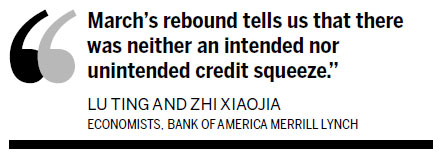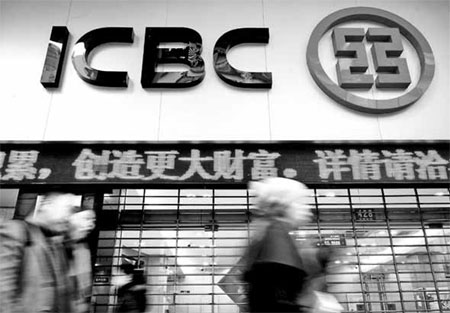Prospects brighter for foreign banks in China
Updated: 2014-05-05 08:19
By Alfred Romann in Hong KongFor China Daily (China Daily)
|
||||||||
But dominance of domestic players limit many to nation's big cities
Foreign banks continue to make inroads in China, but after years of expanding their networks they remain marginal players in retail and consumer spaces.
Still, they are chipping away slowly, building market share and expanding their presence in the financial services sector and among their corporate clients. And regulators are encouraging them.
A series of regulatory announcements last year opened the door for more international activity like trade and cross-border financing at which global banks excel.
In the last half of 2013, regulators in the Chinese mainland announced a series of reforms that paved the way for the further internationalization of the yuan, the liberalization of interest rates and even the creation of the Shanghai Free Trade Zone where foreign banks can offer more services.
In the past few weeks, the People's Bank of China suggested it may further ease restrictions on bond trading. On April 10, the PBOC opened the door to cross-border investment between stock exchanges in Hong Kong and the Chinese mainland. While financial institutions broadly welcomed these moves, the impact might be limited.

In a report in January, global accountancy firm EY noted that foreign banks are generally optimistic about the prospects for the China market but worry about complex regulations that combine with capital and liquidity constraints to make their growth difficult.
By the end of 2012, according to the China Banking Regulatory Commission, there were 42 locally incorporated foreign banks in China and another 370 branches or subsidiaries.
All told, they had assets of 2.3 trillion yuan ($1.8 trillion) but their market share is paltry and remains concentrated in the big cities where they can reach corporate customers.
Although they are expanding geographically in China, foreign banks tend to gather around Guangzhou, Shenzhen, Shanghai, Beijing and Tianjin. There is a smattering of branches elsewhere but they exist to service a handful of corporate clients. Besides the Chinese domestic giants, the largest networks belong to Bank of East Asia, DBS of Singapore, Hang Seng Bank of Hong Kong, Citibank, HSBC and Standard Chartered.
Margins are generally getting tighter for all of them. Among the executives in 38 banks that EY interviewed for their January report, as many as 33 expect their margins from interest rates to get smaller.
Slight improvements
On the other hand, a significant majority of 25 respondents expect to see slight improvements in the market while seven are much more optimistic. The regulatory opening is likely to help to some degree but is not likely to lead to any great surge in market share.
"The benefits for the foreign bankers also significantly depend on the scope, interpretation, timing and implementation of the proposed changes," says Geoffrey Choi, assurance leader for financial services in China at EY.
International banks like HSBC, Standard Chartered, Citibank, UBS and Deutsche Bank, along with a host of other regional players like Overseas-Chinese Banking Corp and DBS in Singapore or Maybank in Malaysia, are expanding their presence.
They are gaining mandates in areas like trade financing, corporate mergers or acquisitions and even larger deals like initial public offerings but, so far, they have not really managed to tap into the retail market. To date, they account for just 2 percent of the market - 1.82 percent at the end of 2012.
The domestic giants like Industrial and Commercial Bank of China or Bank of China continue to dominate with tens of thousands of branches.
Still, for most foreign banks already in the market, China is one of the top three most important growth markets in the world, according to EY.
But there are a significant number of challenges including too many rules and regulations, limited access to the growing bond market and constraints on liquidity and capital.
There are also issues with human resources and difficulties keeping profits up as interest rate margins compress, retail customers stick with the traditional domestic banks and competition grows.
The Chinese government is taking steps to ensure there is no financial crisis of the kind that could be caused by unchecked growth in bad loans. But it is doing so cautiously, aware that curbing credit too much could hurt economic growth.
Data released recently suggest credit is stabilizing and banks are lending again. New loans in March rose to 1.05 trillion yuan from 645 billion yuan in February.
"Investors got quite bearish after the release of the February data," say Bank of America Merrill Lynch economists Lu Ting and Zhi Xiaojia in a note. "March's rebound tells us that there was neither an intended nor unintended credit squeeze."
Even in the slower growth environment in which China finds itself, the economy is expanding faster than just about anywhere else in the world. And the fuel of this economic growth is capital, often in the form of lending. So the country's largest banks continue to grow at home and to expand internationally.
Over the past few weeks, the biggest banks in China reported strong profits through 2013.
The largest bank by assets, Industrial and Commercial Bank of China saw profits rise 10 percent for the year to 263 billion yuan, strong results but much slower than the 15 percent growth in 2012 and the slowest rate of growth since 2006.
The second-largest lender, China Construction Bank, saw its profits rise 11 percent. Bank of China says profits rose 12 percent and Agricultural Bank of China says profits rose 15 percent last year.
For the foreseeable future, the prospects for the banking industry in China appear to be good.
Positive prospects
In a report in early April, rating agency Standard & Poor's says that a "prolonged crisis is unlikely" and that ongoing economic growth, which is likely to stay above 7 percent until at least 2016 will "limit the systemic risk for Chinese banks".
This should also be good news for foreign banks that are looking to China for ongoing growth.
HSBC, which has 160 outlets in 52 cities in China and 30 branches in Beijing alone, expects much from the China market. Much of the bank's growth there is likely to come from financing deals like issuing yuan-denominated bonds.
In a presentation to investors in March, bank executives note that the yuan is now the second most-used currency in trade finance and that by next year, about 30 percent of China's trade, or $2 trillion, will be settled in yuan.
|
Industrial and Commercial Bank of China is an example of a domestic giant dominating the market, making it difficult for regional financial firms to make inroads into China. AFP |
(China Daily USA 05/05/2014 page14)

 Chinese: Parking rules 'unfair'
Chinese: Parking rules 'unfair'
 Demand for bilingual guides on the rise
Demand for bilingual guides on the rise
 Banks using HK as RMB trade center
Banks using HK as RMB trade center
 Houston tries shuttlecock diplomacy
Houston tries shuttlecock diplomacy
 Obama roasts himself, rivals at dinner
Obama roasts himself, rivals at dinner
 H&M promotes summer collections with DJ show in NYC
H&M promotes summer collections with DJ show in NYC
 Forum trends: No house, no marriage?
Forum trends: No house, no marriage?
 One handed climber scales UK's toughest routes
One handed climber scales UK's toughest routes
Most Viewed
Editor's Picks

|

|

|

|

|

|
Today's Top News
Academic lauds US-China partnerships
Chinese premier proposes to upgrade China-Africa cooperation in six areas
E-commerce fuels Chengdu's trade growth
Prospects brighter for foreign banks in China
Travel passes to DPRK made easier
Fast fashion gets sustainable
Yunnan's only panda perking up thanks to TV
Intl cooperation to aid drug fight
US Weekly

|

|









